Written by Guest Blogger: Todd W. Bressi
Meet Me at the Triangles, installed in Wheaton Town Square last October, is the first major artwork commissioned by Montgomery County in many years. The bold sculpture, which offers a jewel box of references to Wheaton as it is now and as it is remembered, was created by artist Norie Sato collaborating with Adrienne Moumin, Eric B. Ricks, Maritza Rivera and Achamyeleh Debela.
Meet Me at the Triangles may have arrived in Wheaton as dawn broke, October 22, but it was years in the making. The sculpture is not only the capstone of a major civic placemaking project in Wheaton, but also represents the intersection of Montgomery County’s public art traditions and new directions.
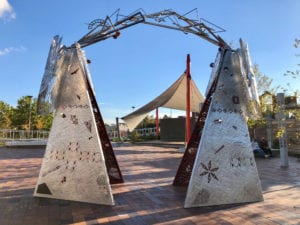 An Intersection of Place
An Intersection of Place
Meet Me at the Triangles is the focal point of a new town square in Wheaton, a community that badly needed such a public gathering place. This square is part of a larger project, the Wheaton Headquarters, a new County office building that represents the largest public and private investment in Wheaton since the construction of Metrorail and the enclosure of Westfield Wheaton.
In a city planning sense, this investment reflects Wheaton’s steady evolution from farmland to suburban residential to auto-oriented retail to an urban downtown, a trajectory repeated in countless places in the Washington region. From a sociological point of view, Wheaton reflects the County’s ongoing evolution from a bedroom community for predominantly white federal workers to a multicultural community with grassroots entrepreneurial energy.
Wheaton Town Square sits at the pedestrian crossroads of these major transportation, retail and office investments. Meet Me at the Triangles sits at the fulcrum of not only of that urban space, but also the social, economic and cultural changes that are shaping Montgomery County’s future — and it therefore suggests the ways in which public art practices will adapt to reflect that.
An Intersection of Public Art Policies
Meet Me at the Triangles came to be through an unusual convergence of Montgomery County’s two signature public art approaches. Since the 1980s, the County has typically commissioned public art whenever it built a new public facility, such as a library, school, park or office building. Also since the 1980s, the County has asked developers seeking certain development approvals to include public art in their projects.
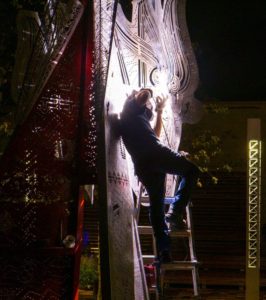
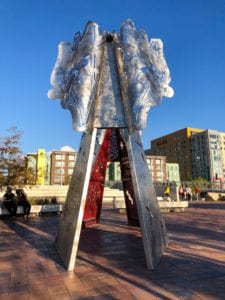
While Wheaton Headquarters is a government office building, it was built by Stonebridge Associates, a private developer, on the County’s behalf. Therefore, the developer was asked to include public art through the process overseen by Montgomery Planning’s Art Review Panel. At the same time, because the artwork would ultimately be added to the County’s public art collection, the County’s Public Arts Trust Steering Committee (which is facilitated by the Arts and Humanities Council of Montgomery County or AHCMC) provided oversight as well. Finally, AHCMC secured a grant from the National Endowment for the Arts to supplement the public art budget, specifically to involve Wheaton artists. As a result, AHCMC and Stonebridge worked hand in hand to conceptualize the project, select an artist and develop a concept for the artwork, while coordinating with the two committees. Stonebridge managed project on a day-to-day basis.
An Intersection of Public Art Practices
Meet Me at the Triangles reflects the convergence of several approaches to public art.
First and most obviously, it is a very traditional piece, a signature sculpture carefully positioned in a major civic space. The artist worked closely with the design team to identify the positioning and scale of the artwork, but worked independently on the theme and actual expression of the piece, an approach that reaches back more than a century to City Beautiful architect–artist collaborations and more recently to “percent-for-art” public art practices, which were the basis of Montgomery County’s original public art approach.
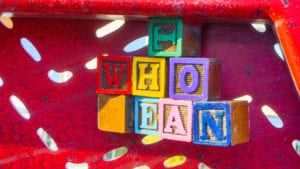 The artwork transcends pure urban design approaches to placemaking to incorporate place-specific meaning, absorbed from the artist’s research into the history of Wheaton and engagement with the community around Wheaton Headquarters. The name of the sculpture, Meet Me at the Triangles, refers to the time when Wheaton Triangle was indeed a meeting place. The waterjet-cut designs and poetry in the sculptural panels and the cast bronze follies welded into the panels and the structures reflect memories and aspirations collected from people in the community. This type of storytelling also draws on the deepest public art traditions.
The artwork transcends pure urban design approaches to placemaking to incorporate place-specific meaning, absorbed from the artist’s research into the history of Wheaton and engagement with the community around Wheaton Headquarters. The name of the sculpture, Meet Me at the Triangles, refers to the time when Wheaton Triangle was indeed a meeting place. The waterjet-cut designs and poetry in the sculptural panels and the cast bronze follies welded into the panels and the structures reflect memories and aspirations collected from people in the community. This type of storytelling also draws on the deepest public art traditions.
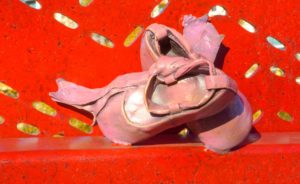 But as public art has evolved, and as urban communities have evolved as Wheaton has, questions have arisen about which artists have access to public art opportunities and whose stories public art tells. A project like this would typically be awarded to a seasoned artist, well-experienced in the technical details of making sculpture at this scale, often selected from a national pool. Meanwhile, people with other creative practices, perhaps those that more closely represent the creative spirit of the community where the artwork is located, would be bypassed simply because of the way the project was defined. Over time, this has contributed to the sense that public art can been exclusive, remote and not well-tuned to the needs of communities, even if it doesn’t explicitly intend to be.
But as public art has evolved, and as urban communities have evolved as Wheaton has, questions have arisen about which artists have access to public art opportunities and whose stories public art tells. A project like this would typically be awarded to a seasoned artist, well-experienced in the technical details of making sculpture at this scale, often selected from a national pool. Meanwhile, people with other creative practices, perhaps those that more closely represent the creative spirit of the community where the artwork is located, would be bypassed simply because of the way the project was defined. Over time, this has contributed to the sense that public art can been exclusive, remote and not well-tuned to the needs of communities, even if it doesn’t explicitly intend to be.
 AHCMC, whose Public Art Roadmap strategic plan notes the evolving cultural composition of the County and charts a course to more inclusive public art opportunities, recognized that a project of this nature would indeed require an artist seasoned in the design, construction and permission process this project would entail. AHCMC was able to secure NEA funds to bring in other artists, from the Wheaton area but not as experienced in public art, onto the team.
AHCMC, whose Public Art Roadmap strategic plan notes the evolving cultural composition of the County and charts a course to more inclusive public art opportunities, recognized that a project of this nature would indeed require an artist seasoned in the design, construction and permission process this project would entail. AHCMC was able to secure NEA funds to bring in other artists, from the Wheaton area but not as experienced in public art, onto the team.
The artist who was selected, Norie Sato of Seattle, was charged with identifying these artists and building a team that could work collaboratively with her on the project. While Sato led the design, fabrication and installation process, she worked with her locally-based collaborators (Moumin, primarily a photographer; Ricks, who is best known for his murals; poet Rivera and Debela, a scholar) to determine the theme of the sculpture and strategies for incorporating the stories of Wheaton into it. Thus, each of the collaborators provided ideas, images, words and small sculptural objects from their own aesthetic practices and artistic viewpoints that enrich the triangular sculptural forms Sato created. The sculptural form marks the place, and the embellishments encourage us to look more closely, again and again and again, so that we can understand and appreciate the place that Wheaton really is.
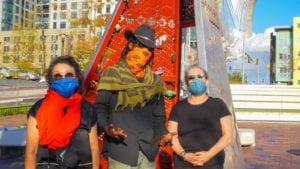 A Harbinger of Things to Come
A Harbinger of Things to Come
Meet Me at the Triangles — nearly four years in the making — offers an early glimpse of what Montgomery County can expect from public art in the future.
- Public art will reflect not only visually-defined urban design frameworks, but also give visual life to the new cultural frameworks that will are shaping the County.
- Public opportunities will follow not only direct public and private capital investments, but also be guided by partnerships – between County agencies; between public, private and non-profit entities.
- Public art investments will be focused on areas that have not been well-served in the past – areas beyond Bethesda and Silver Spring, where developer public art has been concentrated, and beyond sprawling suburban neighborhoods, where County school and park projects have traditionally been concentrated.
- Public art projects will involve more and more types of artists and creative practices, more reflective of the diverse creative energies of people in the County.
Connecting all of these ideas is the fundamental notion that the future of public art in Montgomery County will depend on the sharing of cultural agency, authority and resources. Processes matter, and processes are not neutral. Meet Me at the Triangles demonstrates ways that new processes can create new opportunities, unleash new energies, and enter into a new era of relevance.
